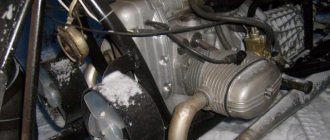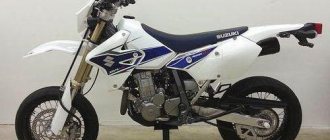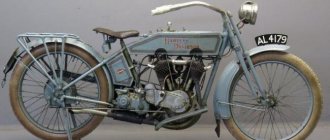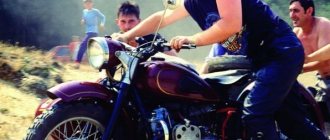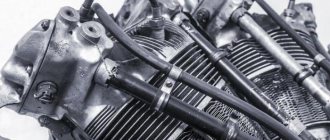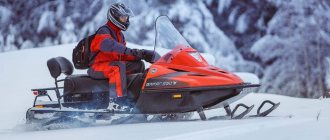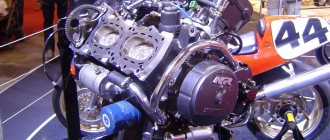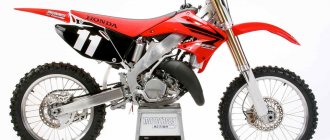IZH Jupiter is a Soviet motorcycle from the Izhevsk Machine-Building Plant, which entered the production line in 1961. This was the very first copy. The designers of the plant achieved a generally successful design, but continued to gradually improve it. Thus, thanks to this, the motorcycle remained relevant for many years, up to several decades. In 1971, the third generation called Jupiter-3 was released. The updated version retains the advantages of its predecessor, including its structural layout.
Motorcycle IZH Jupiter 3 - characteristics and features
Among domestic middle-class motorcycles, the leader was the IZH Jupiter series.
A special feature of these motorcycles was a two-cylinder engine, which provided some advantage over another Izhevsk machine-building motorcycle.
Serial production of IZH Jupiter began in 1961; this series included five generations and was produced until 2008.
Now let’s look at the third generation model “IZH Jupiter 3”.
- Description of design
- Specifications
- Approximate cost
- Photo gallery
- Video
It was no coincidence that this model was chosen, since at one time completely redesigned engines began to be installed on these motorcycles, which had significantly increased power compared to their predecessors , so IZH Jupiter 3 was already the first model of a new generation of motorcycles.
It should also be noted that this motorcycle was produced for a very long time - 10 years (from 1971 to 1981) and in this indicator only IZH-Jupiter 5 surpasses it.
Main disadvantages
All modifications were marked with a quality mark and were generally reliable. Owners of equipment made at the Izhevsk Machine-Building Plant were given headaches by:
- A weak generator, the power of which was not enough to power all electrical appliances at night.
- An ignition system made according to a separate circuit for each cylinder. In general, it is quite reliable, but setting the ignition evenly on the Izh Jupiter 3 is not an easy task.
- The electrical wiring is not of entirely satisfactory quality. Owners of new cars often complained that the wires were mixed up at the factory.
Nevertheless, the popularity of the model was great, and if anything stopped potential buyers, it was the fairly high price. Over the course of a year, the plant produced over 250,000 cars that went on public sale. The successful design became the basis for the creation of the following modifications, the latest of which was Izh Jupiter-5.
Technical characteristics of the basic modification
The new model, although it retained many of the technical solutions that had proven themselves in early modifications, became a significant step forward, having changed both in appearance and in technical characteristics.
The appearance of the car was quite consistent with the design ideas of that time. The technical characteristics looked impressive even in comparison with the parameters of the Java 350 type 634, which appeared a year later.
- The engine is a two-stroke, with two cylinders arranged in a row, and is started by a kickstarter. With the same working volume as Izh Jupiter-2 - 347 cubic meters. see, the power of the power unit has increased almost one and a half times, from 19 to 25 hp. With. Having redesigned the cylinder block and cylinder head, the designers changed the shape and location of the cooling fins, significantly improving the temperature conditions at different speeds.
- Ignition of Izh Jupiter 3 is contact, separate for each cylinder.
- The power system is carburetor, with fuel supplied from the tank by gravity. The standard configuration uses a K-62 carburetor.
- The foot-switched gearbox has four stages and is integral with the engine. The rear wheel drive is chain.
- Clutch - with a multi-plate clutch placed in an oil bath. Control - cable, located on the steering wheel.
- Tubular frame, the design of which uses pipes of different sections.
- The front telescopic fork with increased shock absorber travel is designed for comfortable movement not only on the highway, but also on rough terrain.
- The rear suspension on telescopic shock absorbers turned out to be quite soft, increasing the ride comfort of the Izh Jupiter 3 motorcycle.
- The maximum speed was 120 km/h.
- Fuel tank volume – 18 l. Taking into account the fact that fuel consumption per 100 km is 3.7 liters, a distance of 480 km can be covered on one tank without refueling.
- The dry weight of the Izh Jupiter 3 motorcycle, without oil and fuel, is 162 kg.
Hello dear readers!!! Something terrible happened, I became the owner of the Legendary Soviet Motorcycle IZH JUPITER 3!!! The bike ended up in my possession somehow suddenly and by accident. Good people gave it to me because I didn’t need it, but for some reason I didn’t refuse. Why I needed it and what to do with it, I didn’t really know, but curiosity took over and then one day, in late autumn, this wonderful unit materialized in my garage. The first thing I encountered was that he didn’t want to get into anything. I went to look for the cause and found out that there was no spark. Without hesitation, I went online and looked at a contactless ignition circuit based on a switch and a Hall sensor from VAZoprom. I rummaged around in my bins, found a couple of switches and a sensor, and bought a two-terminal ignition coil from a GAZelle. I found a suitable material, made a platform for the sensor and the “butterfly” modulator. There were doubts about the performance of this system on a 6-volt circuit, but there were encouraging reviews online and I made this whole speed thing work with the motorcycle. He started starting it - he resisted, filled the spark plugs, puffed into the carb and plug, but was in no hurry to start. Without hesitation, I stuck the AZ-1 emergency ignition stray parallel to the Hall sensor; it had been lying in the trunk of a car unnecessarily for many years. I replaced the original K65 carb, battered by life, with a practically new K68 lying on the far shelf of the garage. I changed the spark plugs, injected gasoline under the spark plugs, turned on the AZ and it came to life) It smoked terribly, didn’t hold idle and rattled with everything possible. I tried to drive... Well, it somehow went like hell, but it was somehow sluggish and very smoky... Well, that means I have to dig, I thought and decided to try to revive this carcass with little blood. As a result, over the winter, it was slowly done: The kick-starter shaft, the right crankshaft oil seal, the motor chain were replaced, the clutch was adjusted, the wiring was brought into perfect working order, the seat cover was updated, a couple of burnt out light bulbs, the enrichment lever and cable, pistons, fingers , rings, which I selected for the existing cylinders, since the fate and purpose of owning this device was not at all clear (by the way, only Voshodov pistons of the required size were found) The paintwork of the stroller hood and glove compartments was restored, and I had to strip everything down to the metal and struggle with pockets of corrosion. Also, the paint on the body of the stroller and motorcycle itself was refreshed, but without zealous fanaticism. The stroller was equipped with a new cover and glass (made in China). The shock absorbers, rear suspension and side trailer were rebuilt and filled with oil. The lighting equipment and the stroller brake drive have been restored. The engine didn’t slow down, although there was some play in the lower connecting rod head and in theory it was asking for it, but I decided to leave it until better times. The ignition in the hall behaved tolerably when the engine was warmed up, but it had to be started on a cold one in winter conditions with the help of the Emergency Ignition, otherwise you could get a callus on your right foot due to the constant repeated kicking)) Well, the steering wheel now has a switch button from the hall, at AZ. Winter driving around the garages in a stroller brightened up the winter somewhat and I even liked this thing, but I didn’t go out on the road, because the documents were not renewed for me and the mot was listed as its previous owner (Mot, by the way, was in the same family all his life and changed its owner only once, when it was re-registered in 2000 to the son-in-law of the first owner)
Time passed, spring came, the mapet began to get in the way in the garage and I decided to drive it to the dacha, which was 157 km away. With the re-registration, by the way, there was some hitch, because our glorious tax service, for some reason, suddenly decided to levy tax at the maximum rate. For some reason, in the Vehicle Registration Certificate and in the PTS there was a line: Engine power - “Information Ots.” For all previous years of ownership, the motorcycle was taxed at the rate of the corresponding engine power declared by the manufacturer of 25 hp. and lack of information in the PTS and in the certificate. no one was embarrassed about registration. But in view of innovations in tax legislation, during the ownership period of 2016, tax officials imposed a tax of almost 7,000 rubles on the owner of the motorcycle. The documents were given to the previous owner to eliminate the misunderstanding and the re-registration saga dragged on. The tax office has stubbornly stubbornly continued to stand its ground. How this will all end is still not clear. But somehow I had to move it to its permanent base. I asked them to bring me the documents for the weekend and make a DCT in my name without registering me in the PTS (just in case some valiant traffic police officer might want to stop me and check my documents) And then one Friday, at the end of April, at 3:30 p.m. Having loaded all sorts of belongings and tools onto the motorcycle, throwing a canister with 5 liters of gasoline in reserve into the stroller just in case, putting on my gear, I set out. It was warm, the sun was shining, people were rushing out of the city for dachas and picnics on the eve of the May Day holidays. I roll out of the garages, drive sluggishly, smoke a lot)) In order not to interfere with other road users, I try to drive like everyone else... Announcing the surroundings with the wild roar of the muffler, the strained jerking of the gear lever and unscrewing the trigger all the way, I join the traffic. My mother, how can this be, oo-oo-oooo, yes, what about you, where are you going, damn it, it turns out I don’t even have any brakes!!!! Oh, how do they drive it?!?! Why is he so slow? What is this fog in the mirror? Holy crap, am I making such a fuss?!?! Oh, how can you twist your leg so that you can stick the gear in without getting up?? Why is the steering wheel shaking so much when I was adjusting the stroller?!?! Damn, there are traffic jams right now, it will overheat!!! Ahhhh, right turn, where the hell are you trying to get under me, I won’t fit in!!!! Ufff, well, finally, I pulled onto a straight line without traffic lights or intersections, it’s like I’m on my way!!! Why is that traffic police car looming in my mirror? If we turned on the light, we wouldn’t have found it…. The traffic cops looked with interest at the crazy and insolent motorcyclist on a sidecar from the last century, rolling at 50 km/h. and detaining everyone and everything, grinning and raising his thumb up as a sign of approval, they turned onto one of the secondary roads. Ufff, it seems to have gone by...
Logically reasoning that it’s better to move slowly and systematically in the traffic than to stand at traffic lights every 300 meters for one and a half to two minutes, I turn towards the ring road. I drove out, cranked up the throttle, and it was finally straight and almost without holes. I accelerate to 70 km/h, it’s unusual after a single-pot low-end 4-stroke to listen to a straining 2-cylinder two-stroke. Who said Jupiters don't vibrate???? There is something awkward in the mirrors, some jumping shapes. I drive up to the plug, damn it, but everything is standing still, they drive periodically in 1st gear for about 30 meters and then stand still... So, in my opinion, I need a shoulder. Shaking, not smooth? To hell with it, the main thing is not to stand still, otherwise I’ll overheat, and again with idle, it’s trying to stall at Hall, I accelerate and switch to the emergency ignition, with it it seems to be stable at idle. As luck would have it, it's well into the twenties. I slowly drive around the entire line along the side of the road, turn into the secondary lane, and break out onto the M-8 towards Moscow.
That's it, then it's easier, a straight road and two lanes in each direction. I pass a traffic police post, the owner of the striped stick looks so mysteriously, but doesn’t stop me. As I drive, I switch back to Hall, it seems to be going. I accelerate to 75 km/h, then the strained roar of the engine begins, the traction stars begin. Well, okay, I’m a mopedist, why haven’t I ridden slow-moving sholets?)) I’ve driven 20 kilometers, I feel sick 60-65, it’s boring... Try it, sholet, how long will it go? I pretend to be deaf and, trying not to notice the strained roar of the engine and the blue smoke screen, I unscrew the gas handle. Oooh 85, look, almost 90 already!?!? Wow, what is this 100 km/h??? Wow, what is this, like that same 2-stroke detonation at the top?!?! After 105 km.h. the clutch began to slip and suddenly... Puff, puff, puff, puff, boo-boo-boo-boo-, whizzyyyyyh.... It’s like I’m going deaf, right? I switch to emergency ignition, it seems to work. I drop to the cruising speed of 65 km/h, drive on, and try to switch to Hall. It seems normal, but when you try to give it gas it starts to shut up again.
Well, probably the sensor “went away” due to vibrations and the ignition timing was off, don’t care, I’m driving slowly on the emergency ignition. I drove about 60 km, there was Rostov and an intersection ahead, the oncoming traffic blinked, they were probably at a traffic light. I decided to get up to examine the mapet and give it a rest. As soon as I got up, my relatives flew past in a car, they saw me and stopped. They are also going to the dacha. They asked why I was standing? I explained that everything was fine and I was just cooling down. I decided to go further not along the federal road, but along a short road, there is less traffic there, at least I won’t get in anyone’s way. I explain to my father where I’m going, just in case. I say that if I break down, I’ll call you and meet me. They are leaving. I decided to see what was wrong with Hall while I was cooling down. I unscrew the generator hatch and smell something burning. The sensor and modulator are in place, I unscrewed the spark plug, set TDC, checked the position of the modulator, hmm, everything is in place, nothing is wrong. I’m starting to suspect that the burning smell and the lack of signal from the Hall are somehow connected)) I start the car, reach the intersection, turn onto Belogostitsy and Ilyinskoye-Khovanskoye. There were no traffic cops at the intersection, well, okay, I’m on my way. I say hello to oncoming motorcyclists. I drove about 10 kilometers, attempts to switch to Hall lead to nothing. I remember that I didn’t turn on the light, I decided to turn on the headlights, and then I realized that when I turned it on, the engine began to die out... Soooo, it’s clear, the gene seems to have died... A traffic police car is coming towards me, but where the hell did you come from today? Either you see horseradish for half a year, or in herds))) We drove past. I understand that the further you go, the worse the engine pulls, it’s difficult to climb hills, I even had to switch to 3 a couple of times. I reach Khovansky, drive out onto the road towards Gary and stall. The weather is starting to gloomy, the sky is overcast, and it’s about to start dripping.
I put on a raincoat and climb into the inside of the moped) I try to start the engine - unsuccessfully. Ooppa, they've arrived. I hear by the sound that the AZ is buzzing, which means there is still a spark, why do you need it? I take the hose off the carb, oops, where is the gas? Yeah, of course, I switch to reserve, and it looks like it’s dripping... I close the tap, unscrew the sump, there’s some kind of slurry with garbage in it. I clean it, screw it back, open it - screw it)) Again I transfer it to reserve - it's leaking. Well, okay, I can go, I slobber on the hose back home, look into the tank, there is clearly at least 12-13 liters of gasoline, well, that means the intake pipe is clogged. Okay, this is a small thing, I'll clean it later. I try to start - it starts. I jump into the saddle and ride on. I passed Gary and turned towards Shchennikovo. It began to rain. I stall again, but screw it... I check the fuel supply, everything is fine, it works, which means the battery is dying. The generator indicator light is on low, it looks like it's worn out. I call my father, explain where I am and what’s wrong with me, describe to him in detail the route, how to go, and receive a “Okay” from him. I don’t care, I nod, the engine starts, I’m on my way. I drive three kilometers and stall. I sit, smoke for about five minutes, kick, get started, and drive away. So, in jerks, I reach Rozhny, turn onto the most “fun” section of the road, a forest lane. It was getting dark... It was dripping... Forest... The road is mince, knee-deep puddles, mud, fir trees close to the road and a bend on a bend. The engine starts up periodically, allows you to drive for 200-300 meters and stalls, after sitting for 10-15 minutes it starts up again and again allows you to drive for 200 meters. It got dark, the rain didn’t let up, I got stuck in the mud a couple of times, I didn’t expect the road to become so muddy, but the late flood did its job. There are no cars, people, too, Kraaasotaaaaa))) Something will not see and not hear my saviors, I thought and decided to call .. Hugs are coming, there is no answer. Well, I continue to move in jerks, here and there, where the road profile allows, I push the bike with my hands so as not to sit idle, it rolls hard. The batteries in the headlamp are low, the bots have a “swamp.” Then the call rings, I answer: “Hello, finally, where have you gone?” - “Son, I seem to have gotten lost, turned somewhere and got stuck in such clay that I can’t get out on my own, I have to look for someone who will pull me out...” - “Oh, that’s okay, okay, if I get to you, then I’ll help you dig out...” I understand that I’ll probably have to spend the night in the forest))) I nod, drive a hundred meters, stall, stop unsuccessfully right in a clay puddle, and the wheel of the stroller sank into the sand on the side of the road. I’m waiting for the battery to come to life, and at the same time I’m trying to push the bike out of the abysses, but it’s not really working. I jump on the kick, stick the first one, push as hard as I can, somehow get out. I drive about 50 meters and stall. I smoke again and continue to continue... Then a couple more approaches and I approach the descent, I’m coasting, I see a “full-legged” car coming from the forest, like a KIA Sorrento or something similar, it was dark and I didn’t really delve into it. I stopped, the car caught up with me and stopped... - “Hello! We must have pulled your father out of the quagmire now?” - " Hello! Yes, it looks like it. How far is it from him?” - “No, it’s nearby, around the bend, but he went in the opposite direction, to the village, it’s about a kilometer away, he said he’ll wait there.” - “Cool, thank you, at least they gave me hope, otherwise I was already thinking about spending the night here” - “Yes, it’s okay, don’t bother on the main road, you won’t be able to get through there, go through the forest, it’s drier there...” I thank them for the valuable information, because if If not they, then spending the night in the forest would have been really unavoidable, since they were the only ones on a four-wheel drive vehicle and the second of those that my father and I came across during this entire trip along the outskirts of the Ivanovo region. And if it weren’t for their warning, then, without light, I would absolutely have sunk into the very clay in which my dad was sitting before)) Somehow I get through to my father, the connection is glitchy, on the third attempt I managed to reach him so that he he returned to the puddle from which he was pulled out and waited for me to reach him. I jump on the kick, start up and make a jerk, I managed to get to the turn and the branch going into the forest, apparently this is just a detour of the very quagmire that good people warned me about. I went to look at the road with a flashlight. The main road is really plowed into meat by tractors; it is impossible to pass either with a low-wheel drive or a wheelchair. Yes, even with all-wheel drive, if only with good off-road ground clearance. I followed the turnoff to the left, damn it, but in the forest it diverges into several directions. I’m walking along the one that is as close to the right as possible, to the main road, I can’t see a damn thing, it’s crunching under my feet, but it seems passable. Fortunately, the detour was made through a hill and the worst part is at the end of the descent; you can get through it at full speed. I return to the sidecar, nod, jump into the saddle and make a dash to the middle of the hill, the bike stalls. I’m sitting smoking, enjoying the sound of the rain. I see some glimpses through the trees; my dad approached the quagmire. I jump on the kick and on the first one, twisting the gas to the limit, getting hit in the face by tree branches, I break out of the shit onto a more or less dense road, I see my dad…. Hurray, I got there))) I look at my dad’s Matiz and understand what kind of shit he was stuck in)) There are two embrasures from the windshield wipers on the forehead, the car is covered in solid clay up to the middle of the wheels, you can’t see the side windows, everything is done in clay, there are also lumps on the roof, in swamp salon. Then dad told how he drowned his shoes in the swamp, trying to get out of the car and picked them out of the clay with a stick, because he didn’t have enough strength with his hands, how they were sucked in))))) Grit got used to large puddles along the road, at night it’s hard to see, and It was still raining, I was thinking of rushing through without reconnaissance. So he slipped through... They tied the stroller to the Matiz and dragged themselves to the house with a tie. Damn, he's extreme, you can't see anything, the cable is short, and the stroller has practically no brakes. At least, my attempts to slow down in front of particularly large puddles were not crowned with success; the Matiz was dragging the stroller skidding, sideways and didn’t really notice the load) Somehow we got to Luchki, crossed the Nerl Bridge, and there the asphalt had already begun, although it was paved. From Luchki to the dacha it was 25 kilometers on asphalt, but the potholes, bad brakes of the IZh, rain and lack of lighting did not allow us to drive fast and therefore we drove mostly 25-30 km/h. We finally got there, but we only had to travel 143 km, along the route I was traveling)) For that, now I understand the motorcyclists of the 60s-70s who conquered the same roads, using this very equipment, and were glad that they could do it do. It’s not like you can carry a thousand and a half on the asphalt, with a cruiser under 120, with a gas station every 30 km, motels, navigators and the Internet on your phone)) In general, I liked this eccentric trip and maybe someday I’ll even take a short trip to the strollers along secondary paths.
The next morning I drove the stroller into the garage, kicked the stroller out of the way, removed the right crankcase cover, and dismantled the generator. The diagnosis was confirmed, the rotor was deformed and the generator windings melted. A week later, I brought a generator from Jog, RR and a switch from Alpha from the city, I had to rack my brains a little about how to install this generator into the crankcase of the IZH. A day of tinkering and now I have a generator with permanent magnets, ignition with an inductive sensor and independence from the battery + automatic transition to 12V, which is more common in today’s realities, and cheaper and more reliable ignition components. Only after implementing this whole thing did I finally understand how IZ Jupiter should really drive. It turns out that it can easily go 100+ and you can really feel the kick at the top. Now we need to replace the drive sprocket so as not to cause the engine to twist. Still, I decided not to give up the battery in order to eliminate the blinking of the light at low speeds, and I’ll probably leave the emergency ignition based on the VAZ switch as a backup system, just in case. I apologize for the missing photos, only the ones left were from my phone and they were taken by accident, for the sake of history at the very beginning of the grader road, while it was light. Thanks to everyone who completed this writing!!!
Izh Jupiter
The two-cylinder in-line two-stroke 347 cc air-cooled engine with vertical cylinders (standard for all generations) produced only 18 hp in the first generation. maximum power. It allowed movement at a maximum speed of 110 km/h, and the average fuel consumption on the highway was about 4 l/100 km. From the beginning of production until the end of production, all Jupiters were equipped with front telescopic and rear pendulum suspensions. The sidecar modification of the motorcycle was designated by the index “K” in the name (Izh Jupiter-K).
Izh Jupiter-4
New generations of Jupiter appeared every 3-6 years, constantly increasing engine power and acquiring a more modern appearance. The fourth generation became the most powerful - the Izh Jupiter-4 engine was capable of developing 28 hp. maximum power at 5600 rpm. In this indicator, it even surpassed the “icon” of the entire socialist camp - the Jawa 350 motorcycle (26-27 hp, depending on the modification), almost not inferior to it in maximum speed (125 versus 130-133 km/h). The technical characteristics of the bike were quite comparable to some budget models from well-known foreign manufacturers.
Disadvantages of Izh Jupiter
It's no secret that Jupiters have been criticized for their unreliability and poor build quality. The usual situation was when the owner of the motorcycle, immediately after purchase, tightened all the threaded connections himself and eliminated minor problems (oil leaks, poor contact or shorted wiring). After several thousand kilometers (sometimes earlier), it was necessary to solve the eternal problem of synchronizing the operation of the cylinders, which the single-cylinder Izh Planet did not have. In this regard, the “Izhevsk single-barreled gun” was more reliable and, accordingly, in demand.
In the fifth generation, power was sacrificed in favor of improved torque characteristics at mid-range speeds. The release of the modification “Izh Jupiter-5-020-03” with a liquid cooling system became the culmination and at the same time the “swan song” of the manufacturer. In 2008, motorcycle production in Izhevsk was curtailed.
Interesting
Tuning Izh Jupiter
Like other Soviet motorcycles, Jupiter repeatedly became the object of experimentation and improvement. The result was more or less successful “cross” (long Java fork, different rear swingarm, tires, fenders) and forced (cleaning the cylinder inlet ports, cutting off the “extra” from the pistons and even “trimming” the cylinder heads) devices.
- Legislation
- Reviews
- Miscellaneous
- Motorcycle tuning
Motorcycle IZH Jupiter 3 real fuel consumption per 100 km: reviews
- Ilya, Ussuriysk. It was a pretty good motorcycle for its time. I have a 1977 model. Its fuel consumption level is only 4-6 liters per hundred square kilometers. I do the repairs myself, all consumables and parts are available. In order not to run around car wrecking yards, I purchased another motorcycle of the same type, as a donor (not on the go, I bought it for pennies). Perhaps I was lucky - I got the motorcycle from my uncle, who presented it to me for my birthday. Currently, the distance traveled is 11 thousand kilometers. I had to modify the equipment to some extent - I changed the ignition contacts, the switch, spark plugs, changed the seals in the crankshaft (to do this I had to disassemble the power unit), installed zero high-voltage wires. And that’s probably all - then I started the motorcycle, it started the first time, I sat down and drove off. The power unit quickly reaches speed, and is not demanding on fuel quality. The maximum speed is 100 km/h - I didn’t try to accelerate further. There are five jumpers on the rear wheel - this is very convenient in winter; I go fishing on this motorcycle if there is not enough snow. The battery costs 6 W, thanks to which the engine starts with half a kick.
- Oleg, Tver region. The motorcycle pleasantly surprised me in terms of all identifiers. Model produced in 1986. I’ll immediately note the advantages of Jupiter-3 - cross-country ability, high efficiency, comfortable fit and ergonomic controls. In the end, the motorcycle is worth the money spent. Unfortunately, they don’t make motorcycles like this anymore, so from time to time there are difficulties with a shortage of spare parts; I look for some parts at car dismantling yards - but they are half-dead and of dubious quality. Zero consumables and parts are a big problem to find. And the motorcycle itself is exemplary for agricultural tasks, because it has a high load capacity. In addition, there is still the opportunity to simply go for a ride with the breeze, or go fishing, pick mushrooms and berries, or go into nature. Jupiter-3 is a very difficult motorcycle to control, but after all, the steering wheel feels adequate. The ignition system constantly gets confused, this is interpreted as the reason that one cylinder is consumed (sometimes you don’t notice it), and the motorcycle starts running on one cylinder (the power unit is two-cylinder), because of this, the level of fuel consumption increases. However, in good condition, the level of fuel consumption does not exceed 6 liters per hundred kilometers. Today, it’s not worth purchasing such junk, unless it’s in good condition. And it is imperative to purchase another one of the same kind - as a donor, so that there is no shortage of spare parts.
- Ilya, Chuvash Republic. Endurance, compact dimensions, mobility, durable components and assemblies - all this and much more is characteristic of the IZH Jupiter 3 motorcycle. The power unit dynamically reaches speed and is easy to repair. Perhaps this is the best companion of my childhood. I started riding it with 15 liters. I remember how much fun we had – six of us managed to ride this motorcycle, but this of course is a mockery of the motorcycle. The device itself is quite heavy, and with a high load capacity it will be sluggish. And there is no security. Years have passed, and Jupiter 3 has become a grandfather, but it is still on the move to this day. The power unit is quite impressive and is exemplary for transporting goods. There is enough traction. I liked the degree of acceleration, as well as the noise of the engine - it sings like a nightingale. My motorcycle has been breaking down all my life. There wasn't a day that it didn't break down. Model produced in 1997. Unfortunately, in the post-Soviet years they began to make things much worse in quality; in Soviet times, quality was monitored. However, with timely care, Jupiter 3 will not let you down at all. Unfortunately, they don't make motorcycles like this anymore. In the city, a two-wheeler consumes 3-4 liters per hundred kilometers. On light off-road conditions it is possible to fit in 4-6 liters.
- Leo, Yoshkar Ola. Jupiter 3 is a great option for the unpretentious user. It is good even by current standards, and is able to give heat to some current acceptable models. I have a 1971 model, I periodically look after and care for the motorcycle. Unfortunately, it's hard to find one in good condition these days, but it's worth it. It is unlikely that anyone wishing to purchase Jupiter 3 will regret the purchase if they come across a suitable option. My motorcycle is equipped with a two-cylinder gasoline power unit with 25 horsepower. The engine's thrust and power are sufficient for quick acceleration on any road. The chassis doesn't break through at all. I praise Jupiter-3 for its successful appearance and compact dimensions. The motorcycle dynamically fits into turns, as if it were an example of a lightweight auto-scooter class. Most spare parts can be found on the secondary market; you need to occasionally monitor advertisements from private owners. Zero parts are difficult to find, which is not surprising - after all, Jupiter 3 has not been produced for a long time. Connoisseurs of old technology will certainly appreciate the current motorcycle; it will serve you faithfully for several years. I’ve had it since 1971, and it’s still on the go to this day – a prime example of this. In the city and moderate traffic jams it consumes approximately 3 liters, sometimes it reaches up to 6 liters, no more. It is possible to carry out repairs in the field; this should not cause any difficulties. In any case, all consumables and parts are available, and they are quite reliable.
- David, Chita. This is an old, but very impressive motorcycle. A kind of dinosaur that will be relevant for a long time. The kinetics are normal, the motorcycle confidently crawls up to 100 km/h. Today, the feeling about Jupiter-3 is spoiled by expensive consumables and parts that are constantly in short supply. I purchased this model in 2016 for 4 thousand rubles. The motorcycle was manufactured in 1974, I have been riding it for more than two years. Typical consumption per hundred kilometers. forms 3 liters, fill with AI-92. The power unit produces 24 horsepower, and the maximum speed reaches 120 km/h, according to the technical specifications. I tried to drive up to 130 km/h. There is an opportunity to continue to drive, but at such speeds the motorcycle has a hard time, and for me too - the constant yawing around sometimes gets tiring. Jupiter-3 is interpreted as a representative of the middle class car, which is able to drive on asphalt and dirt roads. I enjoy using it to cover rural paths, with or without a stroller. This motorcycle can be actively used in a village where there are no curious and spartan traffic cops.
- Evgeniy, Republic of Mordovia. It is impossible to get such equipment in good condition these days. And I was lucky, I purchased Jupiter-3 in 1993. It was a used motorcycle, manufactured in 1984, from the first owner. With proper care, the equipment will not fail at all, because it was built back in the days of the USSR, and at that time they made high-quality products - for centuries, so to speak. I praise IZH Jupiter 3 for its high quality workmanship and safety at low speeds. The motorcycle functions like clockwork - it doesn’t break down at all on a long journey, doesn’t make any noise or vibrate. There is no extraneous noise. The fact that the power unit is noisy is acceptable for an old motorcycle. When the time comes, I'll change the muffler and it will run quieter. In the city it consumes 4-6 liters of 92 gasoline, on the highway I use 3 liters. The clutch is original, in perfect order, as is the gearbox. There are no complaints about the quality of production. The seating position is comfortable, the seat does not press or press.
About the disadvantages
It is worth noting that among owners of IZH motorcycles, the Jupiter IZH-4 model is not very popular. Experienced users claim that the fourth “Jupiter” is the most unsuccessful model from the entire range of IZH motorcycles. In addition to the fact that the strength of the high-speed engine leaves much to be desired, Jupiter-4 has the following “diseases” and disadvantages:
- constant oil leakage from the engine crankcase;
- “ringing” of fingers after short use;
- short gearbox resource;
- constant problems with the ignition system;
- high fuel consumption;
- lack of monitoring systems for fuel level, engine temperature and oil level in the crankcase;
- out-of-date design;
- Lack of knowledge in the field of operation and repair of this motorcycle can lead to significant material costs for repairing the unit and/or treating the biker.
Most owners of Soviet motorcycles are confident in the above. Particular attention must be paid to the ignition system. In fact, the process of setting the ignition timing does not require phenomenal skills or special knowledge.
Reviews
Reviews of “Jupiter IZH-4” have both positive and negative. Some of the bike owners are confident that if you treat your equipment with care and carry out technical inspections and repairs in a timely manner, the results will not take long to arrive. When purchasing a motorcycle, you can have virtually zero knowledge regarding repair and operation. The main thing is that the Jupiter IZH-4 was purchased either in good condition or was completely renovated. Then many problems and “diseases” of the motorcycle will not bother the driver.
Reviews
Reviews of “Jupiter IZH-4” have both positive and negative. Some of the bike owners are confident that if you treat your equipment with care and carry out technical inspections and repairs in a timely manner, the results will not take long to arrive. When purchasing a motorcycle, you can have virtually zero knowledge regarding repair and operation. The main thing is that the Jupiter IZH-4 was purchased either in good condition or was completely renovated. Then many problems and “diseases” of the motorcycle will not bother the driver.
Other owners of this motorcycle consider high engine power and excellent acceleration performance to be positive aspects. If you make a few changes to the design, IZH Jupiter-4 can easily take on a modern, attractive look.
Complaints mainly concern unstable voltage regulator relays, problems with the ignition system and rapid wear of engine elements.
How did the motorcycle from the USSR IZH Planet 5 differ from IZH Planet 4
Back in 1962, the first motorcycle called IZH Planet appeared on the assembly line of the Izhevsk Motorcycle Plant. This was the first model of the legendary Planet series, which ended in 2008 with the IZH Planet 5 model. Quite a long history of 46 years, which gave the USSR a number of excellent motorcycles. And if the first motorcycle, for obvious reasons, was very different from the latest model, then the difference between the 4th and 5th models may be minimal, we’ll look at that today.
Let's draw a line between the IZH Planet 4 and IZH Planet 5 models. Well, apart from the year of manufacture, for Planet 4 it is 1983, and for 5 1987 they are distinguished, of course, by their appearance. With the same single-cylinder engine, they have different numbers of exhaust pipes, the Planet 4 has two, and the Planet 5 has one pipe installed. The engine power itself was also different, the 4 had a 20 horsepower engine, the 5 had a 22 hp unit. On the fifth model, the dashboard has been changed, in which the ignition switch is made separately, and on the 4th it is located next to the motorcycle indicator lamps.
Review Jupiter-3 1:1.5 F=5cm P
Jupiter-3 1:1.5 F=5cm P lens was sent for review by Vladimir Mikhailovich.
Review Jupiter-3 1:1.5 F=5cm P
There are many different modifications of Jupiter-3, since the lens itself was produced at several Soviet factories and underwent a number of modifications. My copy number is N5704933, which means the lens was released in 1957 using 'our' Soviet optical glass. This review is very superficial, since, for some reason, I do not currently have the opportunity to test Jupiter-3 with focusing at infinity. Jupiter-3 1:1.5 F=5cm P is a lens from rangefinder cameras with an M39 mounting thread. On SLR cameras without modification it can only be used as a macro lens. I used Jupiter-3 50/1.5 on a Canon EOS 350D camera using a homemade design. how to generally use old lenses with M39 mounting threads on modern Nikon cameras here, and on Canon here.
View of Jupiter-3 50/1.5 at the Central Control Commission
Now, in 2013, Jupiter-3 50/1.5 is sold at flea markets for 150-200 USD. It is considered one of the most legendary lenses of the Soviet Union, although it was originally copied from the German Zonnar. Soviet lenses with apertures F/1.4, F/1.5 can be counted on one hand. An interesting review of the Jupiter-3 converted “to infinity” can be found here.
Type of lens coating Jupiter-3 50/1.5
The lens has a single layer of coating, as indicated by the red letter 'P' in the lens name. The focusing ring rotates 180 degrees; when focusing, the front lens does not rotate, and the lens trunk lengthens slightly. The MDF of the lens is 1 meter. Jupiter-3 50/1.5 is interesting with its 13-blade diaphragm . The aperture is adjusted smoothly, without fixed intermediate values. Very few lenses can boast 13 aperture blades, which form a perfectly even opening that creates the correct circles of blur.
Jupiter-3 lens aperture
Sample photos
Everything was shot at F/1.5. The lens has a chic, unusual design. Many people are simply delighted with the bokeh of the lens. I used Jupiter-3 50/1.5 only in macro mode, so it’s difficult for me to judge the quality of the photo in reality. But still the lens gives a strong yellow-green tint in the photo and has pronounced spherical aberrations at F/1.5.
My experience
On the Canon 350D I mounted the Jupiter-3 50/1.5 not using a conventional adapter, but simply recessed the lens into the camera’s bayonet shaft, and then secured this design with opaque tape. This way I tried to reduce the macro effect somewhat.
I do not recommend throwing away so much money for the Jupiter-3 50/1.5, and the younger brother of the lens, Jupiter-8, can serve as a completely worthy replacement. Jupiter-8 and Jupiter-3 take pride of place in my printed album of 'bokenators'. I was so delighted with the picture of Jupiter-3 that I ordered myself a Jupiter-8 cinema lens for $3. for macro experiments, although I had long sworn “not to buy old manual optics!”
Jupiter-8 and Jupiter-3 take pride of place in my printed album of 'bokenators'. I was so delighted with the picture of Jupiter-3 that I ordered myself a Jupiter-8 cinema lens for $3. for macro experiments, although I had long sworn “not to buy old manual optics!”
Dimensions of two rangefinder fifty dollars
Catalog of modern lenses of the 'Zenitar'
and
'Helios'
can be viewed at this link.
You can comment on the topic and they will definitely answer you, and you can also express your opinion or share your experience.
To select photographic equipment, I recommend large catalogs, for example E-katalog. A lot of little things for photos can be found on Aliexpress. Conclusions:
Jupiter-3 1:1.5 F=5cm P is a small, compact super-fast Soviet fifty-kopeck piece for rangefinder cameras. It has a very nice design, but unfortunately there is no mirror version of the lens. Nowadays, Jupiter-3 50/1.5 is more expensive than many 'native' SLR autofocus fifty dollars.
You can also read interesting information on JUPITER-3 in the review of JUPITER-3 1.5/50 with Contax-Kyiv RF mount.
The material was prepared by Arkady Shapoval. Find me on Youtube | Facebook | | Instagram | Twitter.
